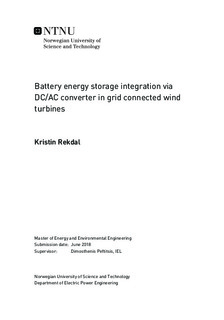| dc.description.abstract | The growing need of battery energy storage to support the increase in renewable production in the electricity mix has brought the attention to the modular multilevel converter (MMC) for medium voltage applications. Modular multilevel converters have been verified the most promising battery interface as it has very high efficiency, excellent AC waveforms, scalable and modular structure and it allows for the use of low rating semiconductors. In addition it provides redundancy due to the ability of distributing the batteries into each submodule. A drawback with the MMC, is that when half-bridge submodules are used, the converter can not handle DC faults, hence it is necessary to understand the dynamics of the converter during various faults.
In this thesis a MMC interfacing a 1 MW battery to the grid is built in \textit{Matwork's Matlab/Simulink}. Both the converter and control system is evaluated and designed in order to evaluate post-fault currents and voltages. The converter was designed with a DC-voltage of 15 kV and five submodules in each arm. The degree of complexity chosen for this model is the submodule level switched model type, including IGBT, reverse diodes and SM capacitors. A high carrier frequency and phase-shifted pulse-width modulation eliminates the need of submodule energy balancing. Five short circuit fault locations have been investigated, two inside the submodule, over one arm, on the DC-link and between two phases on the AC side of the converter. No fault handling strategies, AC- or DC breakers are implemented in the model.
The simulation of short circuit faults inside the submodules reviled that five submodules is not enough to ensure redundancy. The importance of developing fast responding DC breakers was demonstrated as the upper converter arm on phase \textit{a} was short-circuited. As this fault only includes one phase, the first post fault zero-crossing appears to late to prevent damage on the converter. DC breakers are also necessary to prevent the extremely high discharge current from the battery to the fault during the short circuit fault on the DC-link. During the short circuit fault between two phases, all semiconductors will be damaged by the large current if no fault handling is applied, but on the other hand the zero-crossing appears fast enough to isolate the converter from the grid before the damage is done.
The most critical faults are the short circuit faults across one arm and across the DC-link because they both requires DC circuit breakers, which is not yet commercialized. | |

